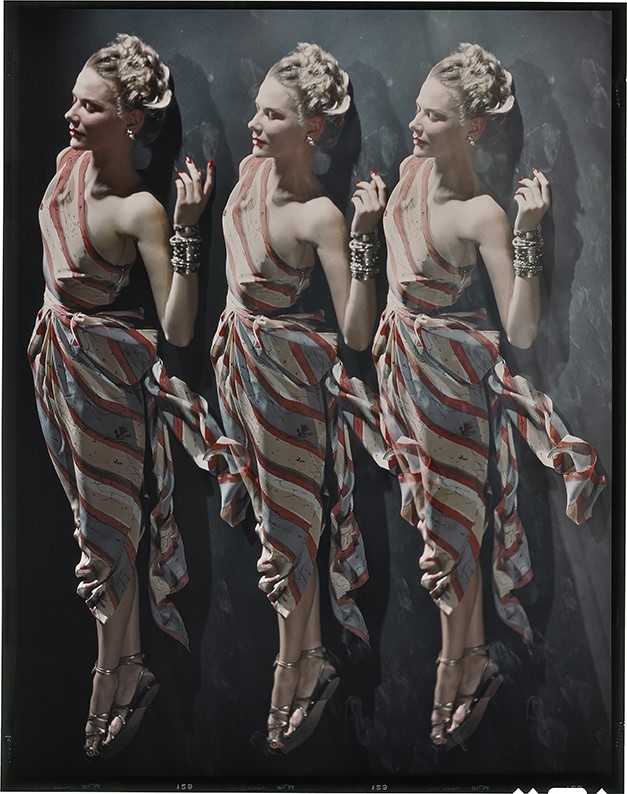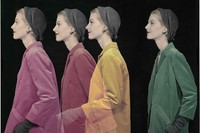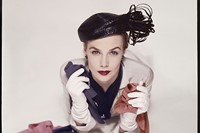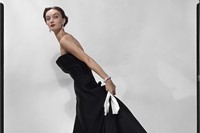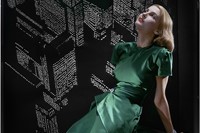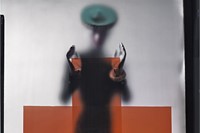To celebrate Somerset House's Erwin Blumenfeld exhibition, AnOther presents 20 facts about the prolific photographer...
To pronounce a photographer as one of the most influential of the 21st century is a pretty big statement. Yet Erwin Blumenfeld's photographic (and film) output and extraordinary career certainly put him in a good position for the crown. Not only a prolific fashion and commercial photographer, Blumenfeld also created reels of groundbreaking fashion films from the early 60s, nudes, personality portraits and Dada collages. His early fashion films were exclusively broadcast on SHOWstudio.com in 2006.
For the past 10 years, Blumenfeld's grandaughter, Nadia Blumenfeld-Charbit,has been working with the Nicéphore Niépce museum in Chalon-sur-Saône to restore the thousands of Blumenfeld's Ektachromes and transparencies. As well as an exhibition which opens at Somerset House this week, focusing on his career in New York between 1941 and 1960, the estate are also preparing a a new website due to go live later this month which will allow all of his work to be accessible in one place.
Here, AnOther presents 20 important facts about the man himself.
1. Blumenfeld was an Aquarius, a starsign which is known for its detatched, progressive, humane, intellectual, flamboyant, sympathetic, and unpredictable characteristics.
2. Blumenfeld first started taking pictures aged 10 when he was given a camera by his uncle Carl.
3. Blumenfeld once stated "I was nothing but a Berliner" in reference to the city as his birthplace, his association with Berlin Dada and also his rejection of Nationalism.
4. Blumenfeld was introduced to his future wife Lena Citroën through his close friend Paul Citroën, her cousin. The pair began exchanging letters, falling in love very quickly. Blumenfeld's love letters comprised Dada collages he had created.
5. Blumenfeld's early collages were created with a brush and scissors, and he combined photographs, paintings and drawings. He was also a talented illustrator.
"Blumenfeld referred to art directors as "arse directors" and was irritated by their involvement in his work."
6. Blumenfeld opened his own company – the 'Fox Leather Company' – in Amsterdam in 1923. It was a leather goods store specialising in ladies handbags, and as part of his marketing strategy, he started taking portraits of beautiful female customers that he would display in the windows. Rapidly, the photographs became more popular than the goods on sale.
7. Blumenfeld loved to break rules and would spend many hours in the darkroom experiementing with printing techniques.
8. Early admirers of his work included Cecil Beaton and Henry Matisse.
9. Blumenfeld's first commission was for French Vogue shortly before his fortieth birthday in 1938.
10. He referred to art directors as "arse directors" and was irritated by their involvement in his work.
11. Blumenfeld was a big fan of Charlie Chaplin and his films had a profound effect on his own groundbreaking film experimentations.
12. In the 1950s, Blumenfeld has become the highest paid photographer in the world.
13. He much preferred his role as an artist to being a fashion photographer.
14. In New York, Blumenfeld worked from 222 Central Park South, a glamorous, double height studio.
15. In 1981, he released a book, briliantly titled My 100 Best Photographs. There was only one fashion image in the edit.
16. Blumenfeld shot one of the most iconic Vogue covers in 1950. The Doe Eye, featuring Jean Patchett, was created using broad and violent lighting. The photographer erased her face, leaving only an eye, mouth and beauty spot.
"Blumenfeld shot the first black woman for Vogue in 1958."
17. Blumenfeld shot the first black woman for Vogue in 1958.
18. There was no major musuem show of Blumenfeld's work during his lifetime.
19. Blumenfeld forced a heart attack on himself (by running up some steps and not taking his medication) because he thought he had prostate problems or cancer.
20. In the 1960s, he worked on his autobiography which found no publisher because it was considered to be too ironic towards society. It was only published after his death.
Blumenfeld Studio: New York, 1941–1960 runs at Somerset House until September 1.
Text by Laura Bradley
